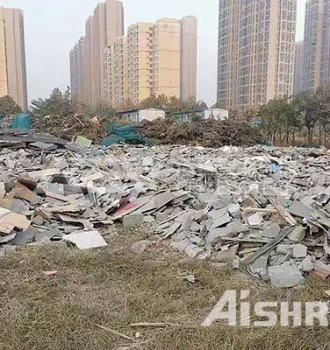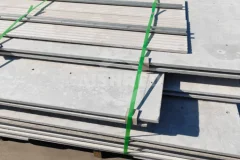
Fiber cement panels and gypsum boards are important materials in modern construction, widely used for their fire-resistant properties. These boards use cement or gypsum as binders, with minerals or other fibers as reinforcing materials, giving them an irreplaceable advantage in the construction industry. However, a large amount of waste is often generated during renovation, demolition, and production processes. This waste not only takes up valuable space but also causes environmental pollution, leading to resource waste becoming a significant issue.To address this problem, one of our customers implemented an innovative solution by shredding the discarded fiber cement boards and gypsum boards and reusing them as raw materials for aerated concrete. This approach not only effectively reduces waste accumulation but also achieves resource recycling, helping to reduce the environmental burden and improve the economic value of the materials.In the recycling process of fiber cement boards and gypsum boards,
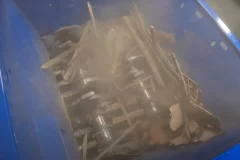
Introduction:Demolition projects generate vast amounts of waste materials that need to be properly managed and disposed of. Traditional methods of handling demolition waste can be time-consuming, costly, and harmful to the environment. However, with the technological advancements in waste processing, the utilization of double-shaft shredders is emerging as a sustainable solution. In this article, we will delve into how double-shaft shredders efficiently process demolition waste to promote efficient waste management practices.Versatile and Robust Design:Double-shaft shredders are engineered with a versatile and robust design, making them ideal for handling a wide range of materials found in demolition waste. These powerful machines can efficiently shred various materials, such as wood, concrete, metal, plastics, and more. The dual-shaft configuration ensures a controlled and uniform shredding process, resulting in consistent particle size reduction.Efficient Size Reduction:Utilizing high-torque rotating
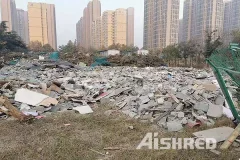
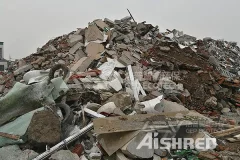
Demolition waste mainly refers to waste materials or waste generated during the process of house improvement, including concrete, mud, bricks and tiles, ceramics, stones, gypsum, aerated bricks, metals, wood, glass, and plastic. At present, the general process for disposal of demolition waste on the market mainly involves converting inorganic matter from it into machine-made sand and recycled aggregates. However, they have not made rational use of the light materials in it and only directly send them to the power plant for incineration. So, how can the light materials in demolition waste be reasonably recycled as resources? AISHRED has launched a production line for using demolition waste as RDF to solve this problem. Firstly, the sorted light materials are sent to a double-shaft shredder for preliminary shredding (shredding size around 150mm-300mm). The shredded materials are uniformly recycled by magnetic separator, and the remaining materials are fed into a trommel screen. The impurities such as slags and
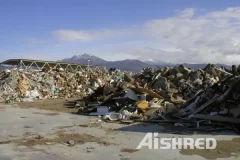
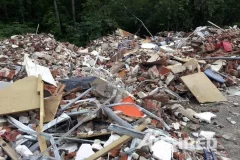
Construction and Demolition Waste Recycling
2022-06-02Construction and demolition (C&D) waste generally constitutes about 10%–20% of total urban solid waste, it includes bricks, tiles, stone, soil, rubble, plaster, drywall or gypsum board, wood, plumbing fixtures, non-hazardous insulating material, plastics, wall paper, glass, metal (e.g., steel, aluminium), asphalt, etc. C&D and other inert waste may be utilised for making bricks, pavement blocks, construction materials such as aggregates etc.The use of C&D waste will minimise the cost of managing such waste and requirement for valuable landfill space, and also save natural resources and reduce the use of virgin soil. Benefits of Processing C&D WasteC&D waste can be put to a profitable use, given the scarcity of sand and stone for construction, thereby saving natural resources.It prevents public nuisance and traffic congestion issues arising from indiscriminate dumping of C&D waste.It saves valuable space at landfill sites.It reduces cost of bulk transportation if recycled close to source of generation.C&D
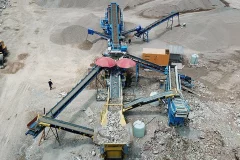
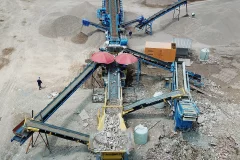
Construction & Demolition Waste Processing
2022-03-03Solid waste from construction, demolition, maintenance and renovation activities not only takes up valuable urban space, but can also lead to soil and groundwater contamination, and many of the valuable materials it contains are a waste of resources. Resourceful disposal of construction and demolition waste can recover most valuable materials and reduce landfill space and environmental pollution.Construction and demolition waste consists of slag, mortar, wood, steel, concrete, gypsum, brick and tile, asphalt and metal, which can be sorted and crushed to achieve metal recovery; brick, tile, concrete and stone can be made into sand and gravel aggregates, mortar or building fill; and combustible materials such as waste wood, plastic and leather fabric can be made into alternative fuels.GEP ECOTECH's shredding, crushing and screening technology makes it easy to tackle the challenges of construction and demolition waste disposal, with easy crushing, efficient sorting and 100% recycling targets. GEP ECOTECH can


